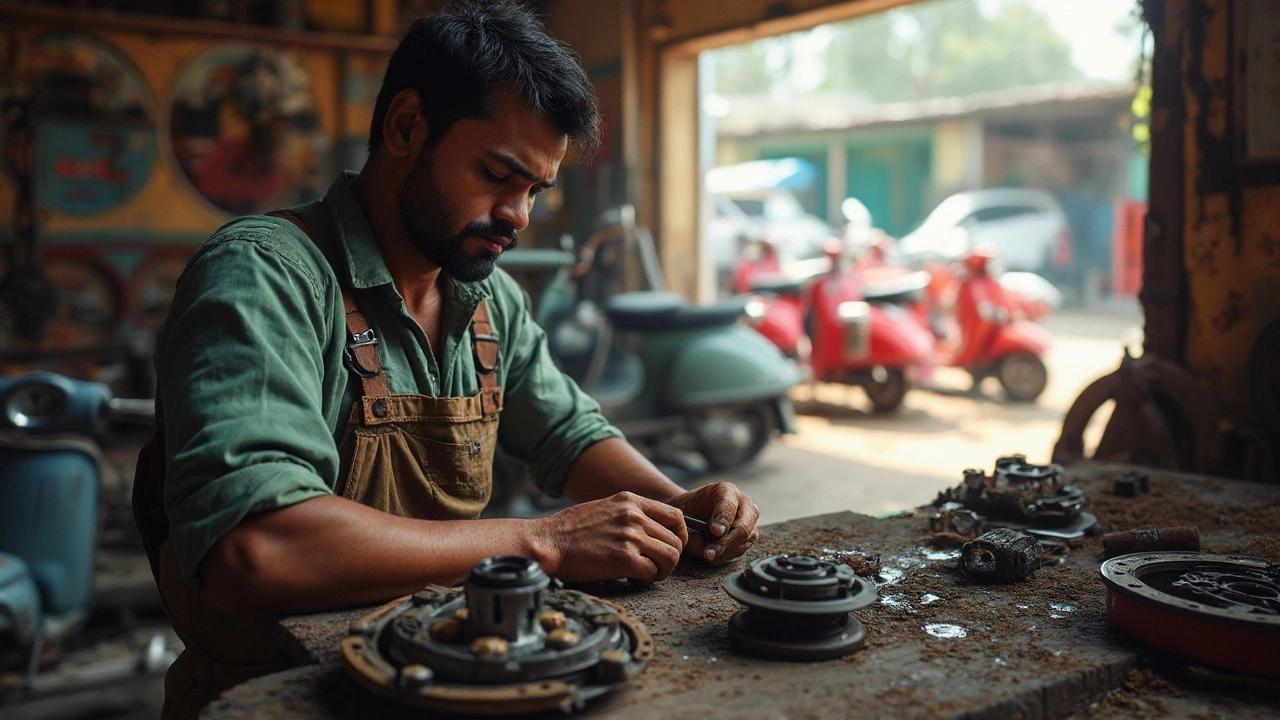 May, 1 2025
May, 1 2025
If you're wondering whether a clutch kit really makes a difference, you're not alone. The truth: it can totally change how your car feels and responds, but only if it matches your driving needs. Think of a clutch kit as more than just a repair—it's a way to reset your whole connection to the gears.
Every clutch wears out over time, and the signs creep up on you. Maybe your shifts feel rubbery, or the clutch pedal gets weirdly stiff or soft. That’s where a clutch kit steps in. Instead of replacing just one piece, a kit gives you all the crucial bits at once—disc, pressure plate, release bearing—the works. This simple swap can bring back that tight, crisp gear change you might not even remember missing.
- What’s in a Clutch Kit, Anyway?
- How Does a New Clutch Kit Change Your Ride?
- Who Actually Needs a Clutch Kit Upgrade?
- Warnings and Tips Before You Buy
- Real-World Stories: Before and After
What’s in a Clutch Kit, Anyway?
When you hear people talk about a clutch kit, they don’t just mean the clutch disc itself. A standard kit usually comes with three main parts: the clutch disc, the pressure plate, and the release bearing. These parts are the real MVPs for keeping your manual car shifting and moving smoothly.
- Clutch Disc: This is basically the meat of the sandwich. It sits between the engine and transmission, grabbing and letting go of power whenever you hit the pedal.
- Pressure Plate: It’s like the muscle of the operation, pressing the clutch disc against the flywheel so your car can send power to the wheels. Without a solid pressure plate, your clutch just slips and your driving feels awful.
- Release Bearing (or Throwout Bearing): This little guy makes sure you can actually push the clutch pedal in without nasty grinding noises. It cushions the movement as you shift gears.
Some kits—especially for sports cars or trucks—throw in extras like a pilot bearing or even an alignment tool. These aren't just random add-ons. The pilot bearing centers the shaft so nothing wobbles, which helps the transmission last longer. The alignment tool is a lifesaver for DIY installs; it lines everything up so you can bolt the transmission back on without wrestling for hours.
Here’s a quick look at what usually comes in popular clutch kit boxes:
| Part Name | Standard Kit | Premium/Performance Kit |
|---|---|---|
| Clutch Disc | ✔️ | ✔️ |
| Pressure Plate | ✔️ | ✔️ (heavy-duty) |
| Release Bearing | ✔️ | ✔️ (upgraded) |
| Pilot Bearing | Maybe | ✔️ |
| Alignment Tool | Maybe | ✔️ |
Swapping your worn clutch with a complete kit makes way more sense than mixing and matching old parts. When everything is fresh and matched, you get better pedal feel, less chance of breakdowns, and a more consistent driving experience—whether you’re stuck in traffic or hammering down a backroad.
How Does a New Clutch Kit Change Your Ride?
Swapping in a clutch kit can do way more than just fix a slipping clutch. For starters, you’ll probably notice the pedal feels more solid, the gear shifts click in smoother, and your car’s overall response improves. It’s the kind of upgrade you feel every time you drive, not just when something’s broken.
Here’s what really happens after installing a new clutch kit:
- Smoother Shifts: Fresh parts mean cleaner engagement between the engine and transmission. No more lurching or awkward hesitations.
- Better Power Transfer: A worn clutch can waste engine power, but a new kit gets it all to the wheels. This is extra important if you’ve added more horsepower or tow heavy stuff.
- Consistent Pedal Feel: Old clutch pedals feel unpredictable. After a new kit, no more guessing how high or low the bite point will be.
- Longer Transmission Life: A strong clutch reduces stress on your transmission, which can mean fewer repairs down the road.
Data from auto shops shows that cars with new clutch kits typically lose gear slip issues and regain consistent shift quality. According to a 2023 report from the Automotive Service Association, about 84% of drivers said their clutch pedal felt more "direct" right after replacement.
| Clutch Performance Before | Clutch Performance After |
|---|---|
| Slips and shudders | Smooth engagement |
| Unpredictable pedal | Solid, consistent feel |
| Delayed shifts | Quicker response |
The biggest change hits you on the first drive. No weird grinding, no random stalling at lights. It’s simply more confidence at every gear change. For anyone who drives stick daily, that alone can make a clutch kit one of the most satisfying upgrades there is.

Who Actually Needs a Clutch Kit Upgrade?
You don’t need a fancy race car to see a real benefit from a clutch kit upgrade. But not every driver needs one right away. Here’s who should pay attention:
- High-mileage drivers: If your car has racked up serious miles and you’re still on the original clutch, you’re probably feeling it slip or jerk. That’s your sign.
- Performance enthusiasts: Folks who tune their cars for more power or love aggressive driving often burn out the stock clutch faster. Upgrading makes sense for added holding power and reliability.
- Tow-ers and haulers: If you use your ride for towing boats, trailers, or anything heavy, your clutch is under way more stress. A stronger clutch kit helps you avoid breakdowns.
- Commuters who drive in heavy traffic: Clutch wear is way worse in stop-and-go situations. If your daily grind is bumper-to-bumper, your clutch gets a workout every day.
It’s not just about when the clutch fails totally. Once you notice weird noises, vibration, or it feels like your pedal is getting lazy, it’s upgrade time. The difference after swapping in a new kit is night and day—think smooth gear changes, more confidence, and less worry about getting stuck on the side of the road.
“Your clutch is like the handshake between your engine and transmission. If it’s weak, everything falls apart fast.” —Mike Kojima, MotoIQ
One interesting stat: according to ServiceBook, the average clutch lasts about 60,000–100,000 miles. But if you drive a turbocharged car or tow regularly, you might only get 30,000–50,000 miles before trouble starts. That’s a lot less than most people expect!
No one wants to get stranded or shell out for emergency repairs. So if you recognize yourself in any of these groups, upgrading your clutch kit before it fails isn’t just smart—it’s peace of mind every time you turn the key.
Warnings and Tips Before You Buy
Shopping for a new clutch kit isn’t like grabbing a new pair of wiper blades. Mess this up, and you’re throwing cash down the drain—or worse, risking more expensive transmission problems. Here’s what you need to check before pressing the buy button.
First off, match the clutch kit to your car model and make. Seems obvious, but with so many options online, it’s easy to get the wrong fit. Always double-check your car’s year, engine type, and even its VIN if possible. Most sellers list compatibility, but don’t trust just a quick filter—read the manufacturer details yourself.
Think about what you actually do with your ride. Is this a daily driver, or are you pushing performance? A stock kit is perfect for everyday use, but if you tow heavy loads or have boosted your engine, look for a performance or heavy-duty kit instead. Using a regular clutch with a souped-up car means you’ll be back in the shop sooner than you want.
The parts inside the kit matter, too. Don’t get caught by "bargain" kits that only include a clutch disc and skip the pressure plate or release bearing. Always grab a complete clutch kit. If you go partial, you’ll just end up tearing down your transmission twice when another cheap part gives out.
- Ask about warranty. Decent clutch kits usually come with at least a one-year warranty. Some even offer two.
- Research the brand. Big names like Exedy, Sachs, or Valeo are trusted for a reason. If the price seems too good, you’re probably looking at a no-name kit from questionable sources.
- Plan for professional install unless you’ve got serious mechanical chops. Messing up a clutch install can leave you stranded, or worse, damage your flywheel or transmission.
If you want a bit of hard data, check out this quick comparison of stock vs. performance clutch kits:
| Kit Type | Average Lifespan (miles) | Pedal Feel | Price Range (USD) |
|---|---|---|---|
| Stock/OE | 50,000 - 100,000 | Smooth/Light | $120-$250 |
| Performance | 40,000 - 60,000 | Firm/Responsive | $250-$500 |
| Heavy-Duty | 60,000 - 100,000 | Stiffer | $200-$400 |
Last thing—save your receipts and keep documentation. If something feels off after install, a legit warranty and clear records mean you can get help without a hassle.

Real-World Stories: Before and After
Wondering if swapping out your old clutch for a brand-new clutch kit actually pays off? Take it from real drivers. These aren’t just stories from the track—everyday folks have seen big changes after installing a kit. Let’s break down what changed for them and what might happen for you.
John drives a 10-year-old Civic and used to hate the sticky, delayed gear shifts. He swapped his worn clutch with a decent clutch kit from a well-known brand. Right after the upgrade, his shifts felt so much smoother and firmer, almost like a new car. He reported that his driving experience didn’t just get better on highways, but also felt easier in stop-and-go city traffic. The main standout for him? No more slipping or grinding gears—even uphill with passengers.
Sarah is into spirited weekend drives with her Mustang. Her stock clutch started slipping at around 60,000 miles, especially when she pushed it. After some research, she picked a performance clutch kit specific to her model. Not only did she get stronger engagement, but her transmission felt a lot more connected. She measured her 0-60 mph times before and after the change—dropping from 6.4 seconds to a consistent 6.1 seconds. Sure, that’s not a night-and-day difference for everyone, but she said it gave her extra confidence whenever she hit the throttle.
| Driver | Car | Main Issue Before | Main Change After |
|---|---|---|---|
| John | Honda Civic (2014) | Sticky, delayed shifts | Smoother, firmer shifts |
| Sarah | Ford Mustang (2018) | Slipping clutch at speed | Faster gear engagement, better launch |
| Alex | VW Jetta (2012) | Noisy clutch pedal, poor engagement | Quiet operation, restored performance |
An interesting detail—most drivers notice immediate gains in performance and the feel of their transmission. One study by a major auto forum surveyed over a hundred people who installed new clutch kits; more than 70% reported fewer shifting problems and longer clutch life. If you think your car feels laggy or unpredictable in the way it shifts, a new clutch kit isn’t just nice to have—it’s often the fix you need.
If you’re on the fence, ask your mechanic if they’ve seen results like these. Or poke around on car enthusiast forums—owners love to share their before-and-after stories, complete with videos and stats. The right clutch kit can transform your daily drive from a slog to something that actually gets you looking forward to hitting the road.